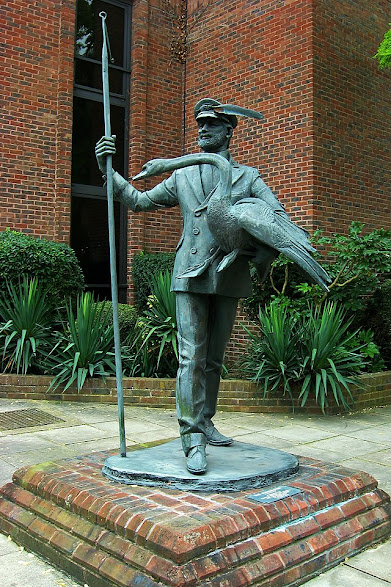Traditional pursuits in July in UK
All images courtesy of Wikimedia Commons
'Swan Upping on the Thames', from Henry Robert Robertson's; 'Life on the Upper Thames.', (1875)
I am
indebted to Andrew for inadvertently suggesting this post.
Roast
swan was a favoured dish in the Tudor courts of Henry VIII and Elizabeth I. Swans are no longer eaten but the ownership of
all mute swans is shared between the sovereign, the Vintners’ Company (Vintners
are people who make and sell wine) and the Dyers’ Company.The Swan Master, by Diana Thomson
The
annual tradition of Swan Upping has been practised for 900 years. This year,
2023, it commenced on Monday, 17th July in Sunbury-on-Thames and will
finish five days later in Abingdon, covering a distance of seventy miles. The
King’s swans are recorded by the Marker of the Swans. They are marked with a ring
linked to the British Trust for Ornithology. Those belonging to the Vintners
and Dyers have an additional ring on the other leg. Originally, the swans’
beaks would be nicked with a metal tool to indicate who owned them, which was probably
no more painful than clipping one’s nails.
Worshipful Company of Dyers' Flag Swan Upping
provides an opportunity to count, weigh and measure the young cygnets, as well
as ringing them. They are also checked for injury, as often birds have been
caught and damaged by fishing lines and hooks.
The Royal Swan Marker commences swan upping in SunburyThe Royal
Swan Uppers wear a scarlet uniform, under the guidance of the King’s Swan Marker,
who wears a swan feather in his cap. The Vintners wear white and are commanded
by their Swan Master and the Dyers wear blue and are under the control of the
Barge Master. All travel in a small fleet of skiffs under the royal flag of King
Charles III. The skiffs work together to pen the birds so that they can be picked up. The cygnets are pulled from the water onto the river bank, quickly
checked and marked and returned to their parents. The cygnets belong to the
same owners as their parents.
Avian flu
had a devastating effect on swans in 2022, hundreds dying from a disease that
is so easily spread in the wider bird population. There is concern that it may
still be wreaking terrible harm. Swan Upping may provide some answers.
Why is it
called Swan Upping? The King’s Swan Marker, David Barber, says that is so called
because the skiffs travel ‘up’ the Thames and pick up the cygnets from the
water.
"PROCLAMATION OF THE LAWS OF MAN. The famous Tynwald Hill from which the laws of the Isle of Man are annually proclaimed in Manx and in English, is situated nine miles from Douglas, and is supposed to be in the very centre of the island. The hill itself is made by the hand of man, and is said to be composed of earth brought from each of the twenty-four parishes of the island. On July 5th, the eve of old Midsummer Day. the quaint and ancient ceremony of proclaiming the laws takes place. The ladies, as is proper in a land where women have long exercised a vote, play a prominent part in the ceremony. It is not till the Acts of Tynwald have been proclaimed from the Tynwald Hill that they become law. The name "Tynwald" itself recalls the language and the history of a very ancient day. It is the same as the Danish Thingvalla and the Icelandic Thingwall and means the "Field of the Popular Assembly."Another tradition
in the UK in July is the annual observance of Tynwald Day, (Laa Tinvaal in
Manx) in the Isle of Man, on 5th July.
On this day, there is an open
air ceremony at Tynwald Hill in the small village of St John’s. The Governor of
the Isle of Man officiates, unless the Sovereign or another member of the Royal
Family, attends. You can read more about it here and here. Bakewell, Derbyshire, 2014
An
interesting tradition that takes place in Derbyshire between May and September
is well dressing, also known as well flowering. Wells and springs are decorated
with mosaics created from flower petals. The origins of the practice are not
clear, and range from a pagan custom offering thanks to the gods for a consistent
water supply, a celebration of water purity after the Black Death, or gratitude
for the constancy of water during a long drought in 1615.
Bradwell, Derbyshire, 2007In 1840,
Buxton introduced well dressing in thanks to the Duke of Devonshire who arranged
and paid for the supply of water to the town. Over time, well dressing was
extended to include piped water taps. Although
principally a Derbyshire tradition, it has also been adopted in various parts
of Staffordshire, South Yorkshire, Cheshire, Shropshire, Worcestershire and
Kent.
Whitwell, Derbyshire, 2012To dress
the well, wooden frames are covered with clay and a design is traced onto it.
Usually, the design is religious in nature, and is completed with flower petals
and mosses, sometimes with the addition of seeds and other natural materials.

_P180_SWAN_HOPPING.jpg)
_and_cygnets.jpg)





.jpg)

